I am working with the R programming language. I am trying to fit a Random Forest model on a very large dataset (over 100 million rows) with imbalanced classes (i.e. binary response variable ratio 95% to 5%). To do this, the R code I wrote:
- Step 1: Creates a training set and a test set for the sake of this Stackoverflow question
- Step 2: Uses sampling with replacement to create many random (smaller) subsets from the training set with a better distribution of the response variable (this is an attempt to increase the "true accuracy" of the model)
- Step 3: Fits a Random Forest model to each of these random subsets and saves each model to the working directory (in case the computer crashes). Note - I am using the "ranger" package instead of the "randomForest" package because I read that the "ranger" package is faster.
- Step 4: Combines all these models into a single model - and then makes predictions on the test set with this combined model
Below, I have included the R code for these steps:
Step 1: Create Data for Problem
# Step 1: Randomly create data and make initial training/test set:
library(dplyr)
library(ranger)
original_data = rbind( data_1 = data.frame( class = 1, height = rnorm(10000, 180,10), weight = rnorm(10000, 90,10), salary = rnorm(10000,50000,10000)), data_2 = data.frame(class = 0, height = rnorm(100, 160,10), weight = rnorm(100, 100,10), salary = rnorm(100,40000,10000)) )
original_data$class = as.factor(original_data$class)
original_data$id = 1:nrow(original_data)
test_set= rbind(original_data[ sample( which( original_data$class == "0" ) , replace = FALSE , 30 ) , ], original_data[ sample( which( original_data$class == "1" ) , replace = FALSE, 2000 ) , ])
train_set = anti_join(original_data, test_set)
Step 2: Create "Balanced" Random Subsets:
# Step 2: Create "Balanced" Random Subsets:
results <- list()
for (i in 1:100)
{
iteration_i = i
sample_i = rbind(train_set[ sample( which( train_set$class == "0" ) , replace = TRUE , 50 ) , ], train_set[ sample( which( train_set$class == "1" ) , replace = TRUE, 60 ) , ])
results_tmp = data.frame(iteration_i, sample_i)
results_tmp$iteration_i = as.factor(results_tmp$iteration_i)
results[[i]] <- results_tmp
}
results_df <- do.call(rbind.data.frame, results)
X<-split(results_df, results_df$iteration)
invisible(lapply(seq_along(results),
function(i,x) {assign(paste0("train_set_",i),x[[i]], envir=.GlobalEnv)},
x=results))
Step 3: Train Models on Each Subset
# Step 3: Train Models on Each Subset:
#training
wd = getwd()
results_1 <- list()
for (i in 1:100){
model_i <- ranger(class ~ height + weight + salary, data = X[[i]], probability = TRUE)
saveRDS(model_i, paste0("wd", paste("model_", i, ".RDS")))
results_1[[i]] <- model_i
}
Step 4: Combine All Models and Use Combined Model to Make Predictions on the Test Set:
# Step 4: Combine All Models and Use Combined Model to Make Predictions on the Test Set:
results_2 <- list()
for (i in 1:100){
predict_i <- data.frame(predict(results_1[[i]], data = test_set)$predictions)
predict_i$id = 1:nrow(predict_i)
results_2[[i]] <- predict_i
}
final_predictions = aggregate(.~ id, do.call(rbind, results_2), mean)
My Question: I would like to see if I can incorporate "parallel computing" into Step 2, Step 3 and Step 4 to potentially make the code I have written run faster. I consulted other posts (e.g.https://stackoverflow.com/questions/14106010/parallel-execution-of-random-forest-in-r, https://stats.stackexchange.com/questions/519640/parallelizing-random-forest-learning-in-r-changes-the-class-of-the-rf-object) and I would like to see if I can reformat the code I have written and incorporate similar "parallel computing" functions for improving my code:
library(parallel)
library(doParallel)
library(foreach)
#Try to parallelize
cl <- makeCluster(detectCores()-1)
registerDoParallel(cl)
# Insert Reformatted Step 2 - Step 4 Here:
stopImplicitCluster()
stopCluster(cl)
rm(cl)
But I am still new to the world of parallel computing and still trying to figure out how to reformat my code so that this will work.
Can someone please show me how to do this?
Note:
In the previous questions that I consulted (e.g.parallel execution of random forest in R, https://stats.stackexchange.com/questions/519640/parallelizing-random-forest-learning-in-r-changes-the-class-of-the-rf-object), the "randomForest" package is used instead of "ranger" I am also open to using the "randomForest" package if this will make it easier to parallelize .
I acknowledge that the overall structure of my code might not be optimally written - I am open to suggestions for re-writing my code if this will make it easier to parallelize.
I realize that there are several popular packages in R that can be used to parallelize code (e.g. https://cran.r-project.org/web/packages/doSNOW/index.html) - I am also open to using any of these packages for parallelizing my code.
